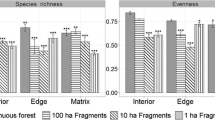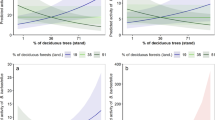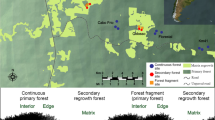Abstract
Context
Disentangling the relative effects of forest loss versus fragmentation on species distribution and abundance is crucial for adopting efficient biodiversity conservation actions, which could change with the nature of the landscape matrix.
Objectives
We tested the moderating effect of landscape matrix on insectivorous bats response to forest loss and fragmentation.
Methods
We conducted acoustic surveys at forest patches surrounded by either an agricultural-dominated matrix or a pine-dominated matrix. We related bat activity to forest amount and the number of forest patches at multiple spatial scales, and compared their effects between landscape matrices.
Results
Bat activity was associated with both predictors, however their effects varied with the matrix type. In agricultural landscapes, as the amount of forest increased, the activity of Histiotus montanus, Lasiurus cinereus and Tadarida brasiliensis increased, while activity of Myotis chiloensis decreased. Similarly, as fragmentation increased, the activity of Lasiurus varius and M. chiloensis increased, while activity of H. montanus decreased. In production-forest landscapes, only H. montanus decreased its activity with increasing forest amount. In contrast, activity of L. cinereus, M. chiloensis and T. brasiliensis increased with increasing fragmentation. Forest amount was a stronger predictor for agricultural landscapes than for production-forest landscapes, suggesting that low contrast matrices can mitigate the effects of forest loss.
Conclusions
Fragmented landscapes with native forest patches surrounded by a low contrast matrix may support a higher activity of insectivorous bats. Management efforts in fragmented landscapes should aim to decrease the patch-matrix contrast, which will mitigate the effects of forest loss on bats.



Similar content being viewed by others
References
Baum KA, Haynes KJ, Dillemuth FP, Cronin JT (2004) The matrix enhances the effectiveness of corridors and stepping stones. Ecology 85(10):2671–2676
Borkin KM, Parsons S (2010a) Plantation forests are used by the lesser short-tailed bat, Mystacina tuberculata rhyacobia. N Z J Zool 37(1):13–17
Borkin KM, Parsons S (2010b) The importance of exotic plantation forest for the New Zealand long-tailed bat (Chalinolobus tuberculatus). N Z J Zool 37(1):35–51
Borkin KM, Parsons S (2011) Home range and habitat selection by a threatened bat in exotic plantation forest. For Ecol Manag 262(5):845–852
Brigham R, Grindal S (1997) The influence of structural clutter on activity patterns of insectivorous bats. Can J Zool 75(1):131–136
Cerezo A, Perelman S, Robbins CS (2010) Landscape-level impact of tropical forest loss and fragmentation on bird occurrence in eastern Guatemala. Ecol Model 221(3):512–526
Chaverri G, Quirós OE, Kunz TH (2007) Ecological correlates of range size in the tent-making bat Artibeus watsoni. J Mammal 88(2):477–486
Crome FHJ, Richards GC (1988) Bats and gaps: microchiropteran community structure in a queensland rain forest. Ecology 69:1960–1969
Cushman SA (2006) Effects of habitat loss and fragmentation on amphibians: a review and prospectus. Biol Conserv 128(2):231–240
Debinski DM (2006) Forest fragmentation and matrix effects: the matrix does matter. J Biogeogr 33(10):1791–1792
Echeverria C, Coomes D, Salas J, Rey-Benayas JM, Lara A, Newton A (2006) Rapid deforestation and fragmentation of Chilean temperate forests. Biol Conserv 130(4):481–494
Elmore L, Miller D, Vilella F (2005) Foraging area size and habitat use by red bats (Lasiurus borealis) in an intensively managed pine landscape in Mississippi. Am Midl Nat 153(2):405–417
Erickson JL, West SD (2002) The influence of regional climate and nightly weather conditions on activity patterns of insectivorous bats. Acta Chiropt 4(1):17–24
Estades CF, Grez AA, Simonetti JA (2012) Biodiversity in Monterrey pine plantations. In: Simonetti JA, Grez AA, Estades CF (eds) Biodiversity conservation in agroforestry landscapes: challenges and opportunities. Editorial Universitaria, Santiago, pp 77–98
Ethier K, Fahrig L (2011) Positive effects of forest fragmentation, independent of forest amount, on bat abundance in eastern Ontario, Canada. Landscape Ecol 26(6):865–876
Ewers RM, Didham RK (2006) Confounding factors in the detection of species responses to habitat fragmentation. Biol Rev 81(1):117–142
Fahrig L (2003) Effects of habitat fragmentation on biodiversity. Annu Rev Ecol Evol Syst 34:487–515
Ferreras P (2001) Landscape structure and asymmetrical inter-patch connectivity in a metapopulation of the endangered Iberian lynx. Biol Conserv 100(1):125–136
Fischer J, Lindenmayer DB, Manning AD (2006) Biodiversity, ecosystem function, and resilience: ten guiding principles for commodity production landscapes. Front Ecol Environ 4(2):80–86
Galaz J, Yáñez J (2006) Los Murciélagos de Chile: Guía para su reconocimiento. Ediciones del Centro de Ecología Aplicada, Santiago
Gascon C, Lovejoy TE, Bierregaards RO Jr, Malcolm JR, Stouffer PC, Vasconcelos HL, Laurance WF, Zimmerman B, Tocher M, Borges S (1999) Matrix habitat and species richness in tropical forest remnants. Biol Conserv 91(2):223–229
Gorresen PM, Willig MR (2004) Landscape responses of bats to habitat fragmentation in Atlantic forest of Paraguay. J Mammal 85(4):688–697
Grindal S, Brigham R (1999) Impacts of forest harvesting on habitat use by foraging insectivorous bats at different spatial scales. Ecoscience 6:25–34
Haila Y (2002) A conceptual genealogy of fragmentation research: from island biogeography to landscape ecology. Ecol Appl 12(2):321–334
Harvey CA, Medina A, Sánchez DM, Vílchez S, Hernández B, Saenz JC, Maes JM, Casanoves F, Sinclair FL (2006) Patterns of animal diversity in different forms of tree cover in agricultural landscapes. Ecol Appl 16(5):1986–1999
Henderson L, Broders H (2008) Movements and resource selection of the northern long-eared myotis (Myotis septentrionalis) in a forest-agriculture landscape. J Mammal 89(4):952–963
Hooper DU, Adair EC, Cardinale BJ, Byrnes JE, Hungate BA, Matulich KL, Gonzalez A, Duffy JE, Gamfeldt L, O’Connor MI (2012) A global synthesis reveals biodiversity loss as a major driver of ecosystem change. Nature 486(7401):105–108
Klingbeil BT, Willig MR (2009) Guild-specific responses of bats to landscape composition and configuration in fragmented Amazonian rainforest. J Appl Ecol 46(1):203–213
Kniowski AB, Gehrt SD (2014) Home range and habitat selection of the Indiana bat in an agricultural landscape. J Wildl Manag 78(3):503–512
Kuenzi AJ, Morrison ML (2003) Temporal patterns of bat activity in Southern Arizona. J Wildl Manag 67:52–64
Kupfer JA, Malanson GP, Franklin SB (2006) Not seeing the ocean for the islands: the mediating influence of matrix-based processes on forest fragmentation effects. Glob Ecol Biogeogr 15(1):8–20
Lacki M, Hayes J, Kurta A (eds) (2007) Bats in forests: conservation and management. JHU Press, Baltimore
Law BS, Anderson J, Chidel M (1999) Bat communities in a fragmented forest landscape on the south-west slopes of New South Wales, Australia. Biol Conserv 88(3):333–345
Lindenmayer DB, Hobbs RJ (2004) Fauna conservation in Australian plantation forests—a review. Biol Conserv 119(2):151–168
Lindenmayer D, Cunningham R, Pope M (1999) A large-scale “experiment” to examine the effects of landscape context and habitat fragmentation on mammals. Biol Conserv 88(3):387–403
McGarigal K, McComb WC (1995) Relationships between landscape structure and breeding birds in the Oregon Coast Range. Ecol Monogr 65(3):235–260
Morris AD, Miller DA, Kalcounis-Rueppell MC (2010) Use of forest edges by bats in a managed pine forest landscape. J Wildl Manag 74(1):26–34
Neter J, Wasserman W, Kutner M (1990) Applied linear statistical models, 3rd edn. Irwin, Chicago
Norberg U, Rayner J (1987) Ecological morphology and flight in bats (Mammalia; Chiroptera): wing adaptations, flight performance, foraging strategy and echolocation. Philos Trans R Soc Lond B Biol Sci 316:335–427
Nupp TE, Swihart RK (2000) Landscape-level correlates of small-mammal assemblages in forest fragments of farmland. J Mammal 81(2):512–526
O’Farrell MJO, Corben CHC, Gannon WLG (2000) Geographic variation in the echolocation calls of the hoary bat (Lasiurus cinereus). Acta Chiropt 2(2):185–196
Prevedello JA, Vieira MV (2009) Does the type of matrix matter? A quantitative review of the evidence. Biodivers Conserv 19(5):1205–1223
Pye JD (1971) Bats and fog. Nature 229:572–574
Quinn G, Keough M (2002) Experimental design and data analysis for biologists. Cambridge University Press, Cambridge
Renjifo LM (2001) Effect of natural and anthropogenic landscape matrices on the abundance of subandean bird species. Ecol Appl 11(1):14–31
Ricketts TH (2001) The matrix matters: effective isolation in fragmented landscapes. Am Nat 158(1):87–99
Ritchie LE, Betts MG, Forbes G, Vernes K (2009) Effects of landscape composition and configuration on northern flying squirrels in a forest mosaic. For Ecol Manag 257(9):1920–1929
Rodríguez-San Pedro A, Simonetti JA (2013a) Foraging activity by bats in a fragmented landscape dominated by exotic pine plantations in central Chile. Acta Chiropt 15(2):393–398
Rodríguez-San Pedro A, Simonetti JA (2013b) Acoustic identification of four species of bats (Order Chiroptera) in central Chile. Bioacoustics 22(2):165–172
Saïd S, Gaillard JM, Widmer O, Débias F, Bourgoin G, Delorme D, Roux C (2009) What shapes intra-specific variation in home range size? A case study of female roe deer. Oikos 118(9):1299–1306
Simonetti JA, Grez AA, Estades CF (2013) Providing habitat for native mammals through understory enhancement in forestry plantations. Conserv Biol 27(5):1117–1121
Sleep D, Brigham R (2003) An experimental test of clutter tolerance in bats. J Mammal 84(1):216–224
Smith AC, Koper N, Francis CM, Fahrig L (2009) Confronting collinearity: comparing methods for disentangling the effects of habitat loss and fragmentation. Landscape Ecol 24(10):1271–1285
Sparks DW, Ritzi CM, Duchamp JE, Whitaker JO (2005) Foraging habitat of the Indiana bat (Myotis sodalis) at an urban-rural interface. J Mammal 86(4):713–718
Trzcinski MK, Fahrig L, Merriam G (1999) Independent effects of forest cover and fragmentation on the distribution of forest breeding birds. Ecol Appl 9(2):586–593
Vergara P, Simonetti J (2003) Forest fragmentation and rhynocriptid nest predation in central Chile. Acta Oecol 24(5):285–288
Villard M-A, Trzcinski MK, Merriam G (1999) Fragmentation effects on forest birds: relative influence of woodland cover and configuration on landscape occupancy. Conserv Biol 13(4):774–783
Walsh A, Barclay R, McCracken G (2004) Designing bat activity surveys for inventory and monitoring studies at local and regional scales. In: Brighamm R, Kalko E, Jones G, Parsons S, Limpens HJGA (eds) Bat echolocation research: tools, techniques and analysis. Bat Conservation International, Austin, pp 157–165
Walters BL, Ritzi CM, Sparks DW, Whitaker JO Jr (2007) Foraging behavior of eastern red bats (Lasiurus borealis) at an urban-rural interface. Am Midl Nat 157(2):365–373
With KA (2002) The landscape ecology of invasive spread. Conserv Biol 16(5):1192–1203
Acknowledgments
We are grateful to L.F. Aguirre (PCMB) for the loan of bat detectors. Special thanks to R. Zúñiga and Y. Cerda for their invaluable help with the fieldwork and D. Rojas for his help with statistical analysis. We are also grateful to the Coordinating Editor and two anonymous reviewers for valuable comments that improved a previous version of the manuscript. This research has been partially supported by FONDECYT 1095046 and Programa Domeyko-Biodiversidad (IT3), Universidad de Chile. A. Rodríguez-San Pedro was supported by a doctoral fellowship from Comisión Nacional de Investigación Científica y Tecnológica (CONICYT), Chile.
Author information
Authors and Affiliations
Corresponding author
Electronic supplementary material
Below is the link to the electronic supplementary material.
Rights and permissions
About this article
Cite this article
Rodríguez-San Pedro, A., Simonetti, J.A. The relative influence of forest loss and fragmentation on insectivorous bats: does the type of matrix matter?. Landscape Ecol 30, 1561–1572 (2015). https://doi.org/10.1007/s10980-015-0213-5
Received:
Accepted:
Published:
Issue Date:
DOI: https://doi.org/10.1007/s10980-015-0213-5




